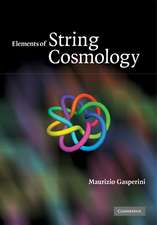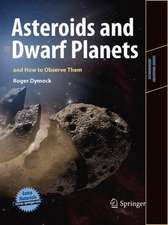Science with the Atacama Large Millimeter Array:: A New Era for Astrophysics
Editat de Rafael Bachiller, José Cernicharo Quintanillaen Limba Engleză Paperback – 17 noi 2014
This book describes the enormous capabilities of ALMA, the state of the project, and most notably the scientific prospects with such a unique facility. The book includes comprehensive reviews and recent results on most hot topics of modern Astronomy (the formation and evolution of galaxies, the physics and chemistry of the interstellar medium, and the processes of star and planet formation) with prospects to the revolutionary results to be obtained with ALMA. These topics, discussed with special emphasis on millimeter and sub-millimeter astronomy, are presented by some of the most world-wide reputed scientists in their fields.
| Toate formatele și edițiile | Preț | Express |
|---|---|---|
| Paperback (1) | 1231.01 lei 6-8 săpt. | |
| SPRINGER NETHERLANDS – 17 noi 2014 | 1231.01 lei 6-8 săpt. | |
| Hardback (1) | 1082.78 lei 38-44 zile | |
| SPRINGER NETHERLANDS – 7 mai 2008 | 1082.78 lei 38-44 zile |
Preț: 1231.01 lei
Preț vechi: 1501.23 lei
-18% Nou
Puncte Express: 1847
Preț estimativ în valută:
235.55€ • 246.60$ • 194.90£
235.55€ • 246.60$ • 194.90£
Carte tipărită la comandă
Livrare economică 05-19 aprilie
Preluare comenzi: 021 569.72.76
Specificații
ISBN-13: 9789401784849
ISBN-10: 9401784841
Pagini: 368
Ilustrații: XXXII, 335 p.
Dimensiuni: 210 x 279 x 19 mm
Greutate: 0.83 kg
Ediția:2008
Editura: SPRINGER NETHERLANDS
Colecția Springer
Locul publicării:Dordrecht, Netherlands
ISBN-10: 9401784841
Pagini: 368
Ilustrații: XXXII, 335 p.
Dimensiuni: 210 x 279 x 19 mm
Greutate: 0.83 kg
Ediția:2008
Editura: SPRINGER NETHERLANDS
Colecția Springer
Locul publicării:Dordrecht, Netherlands
Public țintă
ResearchCuprins
The Atacama Large Millimeter/Submillimeter Array: overview & status.- ALMA capabilities for observations of spectral line emission.- ALMA capabilities for observations of continuum emission.- Star and planet-formation with ALMA: an overview.- High-mass star forming regions: An ALMA view.- Early stages of star formation.- Chemistry in low-mass star forming regions.- Molecular outflows observed with ALMA.- Unveiling the chemistry of hot protostellar cores with ALMA.- High resolution submillimeter observations of massive protostars.- High-resolution mm interferometry and the search for massive protostellar disks: the case of Cep-A HW2.- The Class 0 source Barnard 1c.- APEX and ATCA observations of the southern hot core G327.3-0.6 and its environs.- The physical conditions in the BHR71 outflows.- Interstellar deuteroammonia.- Massive star formation in the southern Milky Way.- SMA observations of the magnetic fields around a low-mass protostellar system.- ASTE observations of the massive-star forming region Sgr B2: a giant impact scenario.- A new view of proto-planetary disks with ALMA.- Observational signature of planet formation: The ALMA view.- Detecting protoplanets with ALMA.- The study of young substellar objects with ALMA.- A submillimeter view of protoplanetary dust disks.- Studies of dense cores with ALMA.- Chemistry in the ISM: the ALMA (r)evolution.- High angular resolution imaging of the circumstellar material around intermediate mass (IM) stars.- Polarization measurements of molecular lines.- Molecular clouds and star formation in the Magellanic Clouds and the Milky Way.- Complex organic molecules in an early stage of protostellar evolution.- Revealing the “fingerprints” of the magnetic precursor of C-shocks.- A new evolutionary scenario ofintermediate-mass star-formation revealed by multi-wavelength observations of OMC-2/3.- Scientific role of ACA for low-mass star-formation study.- Planetary atmospheres with ALMA.- Cometary science with ALMA.- Observations of asteroids with ALMA.- ALMA as the ideal probe of the solar chromosphere.- The study of evolved stars with ALMA.- Molecular lines from protoplanetary nebulae: observations with ALMA.- Planetary nebulae and ALMA.- Chemistry in the circumstellar medium.- Understanding the chemical complexity in Circumstellar Envelopes of C-Rich AGB stars: the case of IRC +10216.- New Plateau de Bure observations of M?1–92; unveiling the core.- A massive, dusty toroid with large grains in the pre-planetary nebula IRAS22036+5306.- Gas dynamics and structure of galaxies.- Investigations of star formation in galaxies using ALMA.- Probing the feeding and feedback of activity near and far.- Chemical complexity in galaxies.- Chemistry in luminous AGN and starburst galaxies.- Dense gas in normal and active galaxies.- Spectroscopic surveys of cosmic evolution.- Observations of molecular clouds in nearby galaxies with ALMA.- Luminous infrared galaxies with the submillimeter array: probing the extremes of star formation.- The Galactic Center as nearby extragalactic chemical laboratory.- Studying the first galaxies with ALMA.- Detecting the most distant (z>7) objects with ALMA.- Redshift distribution of the submillimeter extragalactic background light.- Molecular absorptions in high-z objects.- Molecular signature of star formation at high redshifts.- Dense molecular gas in a sample of LIRGs and ULIRGs: The low-redshift connection to the huge high-redshift starbursts and AGNs.
Notă biografică
Rafael Bachiller is the director of the Spanish Observatorio Astronómico Nacional (OAN). He received his doctorate in physics at the University Joseph Fourier (Grenoble, France). His research interests include the molecular content of planetary nebulae and the processes of star formation with special emphasis in the bipolar molecular outflows and their chemistry.
José Cernicharo is a research professor at the Spanish Consejo Superior of Investigaciones CientÃficas. He received his doctorate in physics at the University of Paris IX. He is project scientist of the Herschel Space Observatory. His research interests cover most aspects of molecular astrophysics (identification of interstellar molecular species, physics and chemistry of the interstellar and circumstellar media, study of water vapour in space, etc).
Both are world-wide recognized specialists in millimeter/submillimeter astronomy and have been involved in ALMA from the genesis of the project to the more recent participation in the advisory and governing bodies (namely in the Scientific Advisory Committees and the ALMA Boards).
José Cernicharo is a research professor at the Spanish Consejo Superior of Investigaciones CientÃficas. He received his doctorate in physics at the University of Paris IX. He is project scientist of the Herschel Space Observatory. His research interests cover most aspects of molecular astrophysics (identification of interstellar molecular species, physics and chemistry of the interstellar and circumstellar media, study of water vapour in space, etc).
Both are world-wide recognized specialists in millimeter/submillimeter astronomy and have been involved in ALMA from the genesis of the project to the more recent participation in the advisory and governing bodies (namely in the Scientific Advisory Committees and the ALMA Boards).
Textul de pe ultima copertă
Currently under construction in the Andean Altiplano, Northern Chile, the Atacama Large Millimeter Array (ALMA) is the most ambitious astronomy facility under construction. ALMA is a radio interferometer composed of 54 antennas of 12 m diameter, and twelve 7 m antennas with about 6600 square meters of total collecting area. Initially covering the most interesting spectral wavelength ranges from 3 to 0.3 mm, ALMA will be a revolutionary telescope aimed to unveil the details of star and planet formation and to provide astronomy with the first exhaustive view of the dark and youngest objects of the Universe.
This book describes the enormous capabilities of ALMA, the state of the project, and most notably the scientific prospects with such a unique facility. The book includes comprehensive reviews and recent results on most hot topics of modern Astronomy (the formation and evolution of galaxies, the physics and chemistry of the interstellar medium, and the processes of star and planet formation) with prospects to the revolutionary results to be obtained with ALMA. These topics, discussed with special emphasis on millimeter and sub-millimeter astronomy, are presented by some of the most world-wide reputed scientists in their fields.
This book describes the enormous capabilities of ALMA, the state of the project, and most notably the scientific prospects with such a unique facility. The book includes comprehensive reviews and recent results on most hot topics of modern Astronomy (the formation and evolution of galaxies, the physics and chemistry of the interstellar medium, and the processes of star and planet formation) with prospects to the revolutionary results to be obtained with ALMA. These topics, discussed with special emphasis on millimeter and sub-millimeter astronomy, are presented by some of the most world-wide reputed scientists in their fields.
Caracteristici
Describes the enormous capabilities of the Atacama Large Millimeter Array (ALMA), the state of the project, and most notably the scientific prospects with such a unique facility Provides the science case for ALMA, the most ambitious telescope in construction of present-day Astronomy Covers most hot topics of modern Astronomy (from the Solar System to high-z galaxies, with important articles on molecular clouds, star and planet formation, etc.) with prospects to the revolutionary results to be obtained with ALMA Contains recent results on millimeter and sub-millimeter astronomy presented by the most reputed scientists in the field















